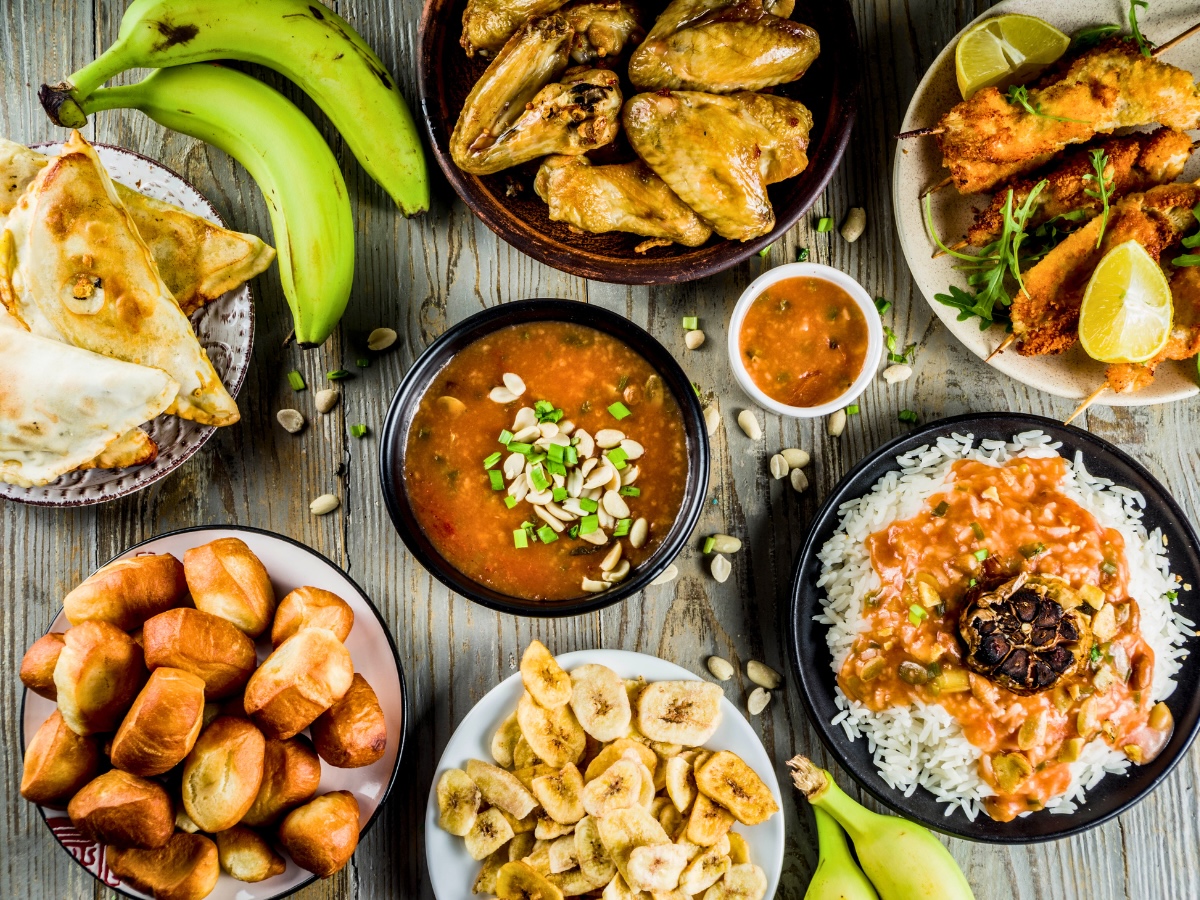In the bustling streets of Zanzibar, the aroma of freshly cooked pilau and spiced samosas wafts through the air, enticing both locals and tourists alike. This is the vibrant world of Swahili cuisine, where each dish tells a story of centuries-old cultural blends and heritage. How does this rich culinary tradition continue to shape Tanzanian identity on the global stage?
Swahili cuisine is a reflection of Tanzania’s historical tapestry, beautifully interwoven with Indian, Persian, and Arabic influences. As the spice trade flourished in ancient times, vibrant spices like cloves, cinnamon, and cardamom became integral to local cooking. With nearly 40% of Tanzanians engaging in agriculture, the cuisine is deeply rooted in the harvest of local produce, offering a harmonious blend of flavors that represent Tanzania’s diverse cultural landscape.

Swahili Cuisine: A Rich Fusion of Cultural Influences
Swahili cuisine is like a delicious melting pot of flavors, bringing together tastes from various cultures. The blend of Arab, Persian, and Indian influences is evident in the intricate use of spices and cooking methods. Each region along the Swahili coast offers its unique twist, showing colorful traditions and a shared love for food. Many dishes, like pilau and biryani, showcase these diverse backgrounds. This culinary fusion makes every meal an exciting journey.
The history of Swahili cuisine is a tale of trade and migration. Traders and settlers from different parts of the world brought their cooking styles and ingredients to the coast of East Africa. Over time, these influences mixed with local traditions, creating something entirely new. The result is a rich culinary tradition enjoyed by Tanzanians and visitors alike. According to here is the article, this blending of cultures is what makes Swahili food so unique.
Spices play a central role in Swahili cooking, adding depth and warmth to each dish. Common spices include cloves, cinnamon, and cardamom, which give dishes their distinctive flavor. These spices traveled to East Africa through ancient trade routes. They are now so deeply embedded in local recipes that they have become fundamental to Tanzanian cuisine. This aromatic symphony is a testament to the diverse influences at play.
For a taste of Swahili culture, exploring traditional dishes is a must. Some of the most popular dishes are fragrant pilaf rice, spicy samosas, and coconut-infused curries. These foods are often part of special occasions and celebrations, bringing people together to share in the joy of eating. The variety in Swahili cuisine means there is always something new to try. According to this post, cuisine continues to evolve, adapting to modern tastes while honoring its roots.
What the Chaga Tribe Eats in a Day!! EXTREME African Food in Tanzania!!
The Traces of Arab, Persian, and Indian Influences in Swahili Cuisine
The vibrant Swahili cuisine is a patchwork of flavors and traditions brought by Arab, Persian, and Indian settlers. Each culture added its flair to local ingredients, creating a unique blend. The use of spices, like saffron and coriander, reflects the Persian influence. Additionally, many sweet dishes trace their roots back to Arab culinary techniques. The combination of these diverse elements makes Swahili food a delightful experience.
The Arab influence is most noted in dishes like nyama choma, where meat is seasoned and grilled in ways that are reminiscent of Middle Eastern standards. On the other hand, Indian traders introduced dishes like chapati and samosas, which have become staples in Tanzanian households. These foods are not only delicious but tell stories of cultural exchange. They represent the union of culinary traditions from across the Indian Ocean. It’s amazing how these foods continue to be popular today.
Persian merchants added another layer of flavor, with their emphasis on rice and stews. Iranian dishes often included rich sauces and flavorful rice, elements that are now integral to Swahili cuisine. For example, the beloved pilau rice shows the delicious results of these influences. This dish, with its aromatic spices, connects the past to the present. It’s a wonderful example of cultural harmony.
Over time, these cultural traces have evolved and adapted, becoming something uniquely Swahili. Ingredients like coconut, found in many coastal regions, blend beautifully with foreign spices. A delightful fusion results, enjoyed by locals and visitors alike. The evolution of these dishes over centuries shows the adaptability and resilience of Swahili cuisine. It stands as a testament to the rich, shared history along the Swahili coast.
The Significance of Spices in Swahili Cuisine
In Swahili cuisine, spices are the heart and soul, offering vibrant flavors and enticing aromas. These spices were introduced through centuries of trade and cultural exchanges. Common spices like cloves, cinnamon, and cardamom are staple ingredients. Each spice has a history, often used to tell tales of travel across seas. Their usage transforms simple ingredients into complex, delightful dishes.
The spices bring warmth and depth to various Swahili dishes. For example, cloves add a distinct aroma to rice dishes, making them a feast for the senses. Curries become rich and flavorful with a blend of turmeric and cumin. Even simple breads like chapati are elevated with a touch of spice. This is the magic of spices in Swahili cooking.
Swahili cuisine relies heavily on spice blends, which are often passed down through generations. These blends are unique to each family, telling a personalized story of heritage through flavor. They add a signature twist to well-loved dishes. Using these spices showcases a deep-rooted cultural connection. It’s a celebration of flavors, bringing families together over shared meals.
Beyond flavor, spices in Swahili cuisine play significant roles in health and wellness. Many spices boast medicinal properties, aiding digestion or boosting immunity. They ensure that meals are delicious and nutritious. This holistic approach to cooking underlines the time-honored traditions of the Swahili people. It’s about nourishing both body and soul through every meal.
Popular Dishes and Recipes in Swahili Cuisine
Swahili cuisine is renowned for its flavorful dishes that beautifully combine different cultural influences. One of the most beloved dishes is pilau, a fragrant rice dish infused with spices such as cloves and cinnamon. Often cooked with meat or chicken, pilau is a staple at family gatherings. The aroma can fill a home with joy, enticing everyone to the table. It’s not just a meal; it’s a celebration.
Biryani is another popular dish, known for its rich and aromatic flavor. Unlike pilau, biryani often includes layers of meat and rice cooked separately before being combined. This method results in fluffy, flavorful rice that pairs perfectly with tender, spiced meat. Many families have their own secret biryani recipes passed down through generations. It’s a dish that can make any occasion special.
Seafood is abundant along the Swahili coast, with dishes like grilled fish and prawns being local favorites. Coconut milk is frequently used in these dishes, adding a creamy texture and rich flavor. The blend of spices and coconut is a classic in Swahili cooking. It’s both delicious and a reminder of the coastal influence in the cuisine. Seafood lovers will find plenty to savor in Swahili dishes.
Samosas are a popular snack or appetizer, crispy on the outside and bursting with flavor on the inside. Filled with spiced meat or vegetables, they are often served with chutney. Samosas are enjoyed during festive seasons and special events. They’re a perfect example of Indian culinary influence blending seamlessly into Swahili cuisine. With each bite, you experience a burst of spices and textures.
For those with a sweet tooth, Swahili cuisine offers a variety of desserts. Mabuyu, a candied baobab fruit, is a local favorite. Cakes and puddings flavored with coconut and cardamom also provide a sweet ending to meals. These treats are indulgent and imaginative, celebrating the variety of local and imported ingredients. Desserts in Swahili cuisine are more than just sweet treats; they’re a cultural experience on their own.
Swahili Cuisine in Tanzanian Celebrations and Festivals
In Tanzania, Swahili cuisine is an essential part of celebrations and festivals. When families gather for weddings, holidays, or special events, the table is filled with delicious dishes. Traditional meals such as pilau, biryani, and chapati take center stage. These foods bring people together, creating moments of joy and unity. Sharing food is a way to connect with loved ones and celebrate cultural heritage.
During the holy month of Ramadan, Swahili cuisine plays a significant role in iftar, the meal to break the fast. Families often prepare dishes like samosas, mandazi, and mkate wa kumimina to enjoy at the end of the day. These dishes are not only tasty but also nourishing after a day of fasting. Food sharing during Ramadan fosters a sense of community and togetherness. It’s a reflection of gratitude and kindness.
Festivals in Tanzania, such as the Swahili Festival or Sauti za Busara, feature local cuisine to enhance the experience. Street vendors and local chefs showcase their best Swahili dishes. Visitors are treated to an array of foods that highlight the rich flavors of the region. Adding food to the festivities enhances cultural appreciation. Festivals become a feast for both the senses and the soul.
When celebrating milestones, such as births or anniversaries, food is central to the occasion. Guests are greeted with a variety of sweet and savory treats. The sharing of elaborate meals symbolizes abundance and good fortune. Cooking together is also a cherished tradition. It’s a way for families to bond and pass down recipes.
Traditional foods are served with a sense of pride and love. Eating together becomes a joyous ritual, enjoyed by the young and old. This enduring practice reflects the importance of food in Tanzanian life. It’s a testament to the power of Swahili cuisine in bringing people together. Every meal is a celebration of culture and togetherness.

Frequently Asked Questions
Swahili cuisine showcases a variety of flavors resulting from Tanzanian cultural diversity. Its rich history highlights influences from Arab, Persian, and Indian culinary traditions.
1. What are the main ingredients used in Swahili cuisine?
Swahili cuisine primarily focuses on aromatic spices, like cloves, cinnamon, and cardamom, which elevate the flavors of various dishes. Alongside these spices, coconut milk is a common ingredient, providing richness and a tropical touch to stews and curries.
Fresh seafood, such as fish and prawns, is also essential, reflecting the coastal geography. Local produce, including fruits like mangoes and vegetables, adds a vibrant and fresh element to many dishes, showcasing the region’s abundant resources.
2. How has Swahili cuisine evolved over time?
Swahili cuisine has evolved through centuries of cultural exchanges and trade along the East African coast. Arab and Persian traders first introduced spices, while Indian migrants further enriched the culinary landscape with their dishes, like chapati and samosas.
As globalization continued, the cuisine adapted to incorporate new influences while retaining its unique identity. This evolution reflects a blend of tradition and innovation, keeping Swahili cuisine both historic and contemporary.
3. How do Tanzanians celebrate special occasions with Swahili cuisine?
Tanzanian celebrations often feature Swahili cuisine as a central element, bringing families together over shared meals. Special occasions like weddings and Eid involve elaborate feasts with dishes like pilau, biryani, and samosas, showcasing the region’s rich culinary heritage.
Food serves as a means of connecting with loved ones, reflecting hospitality and community. These celebrations highlight the importance of food in creating lasting memories and honoring cultural traditions.
4. What role do spices play in Swahili dishes?
Spices in Swahili cuisine are integral, enhancing dishes with depth and aroma. They were introduced through trade routes, providing a sensory experience unique to this culinary style.
Spices like turmeric, cardamom, and cloves not only enhance flavor but also possess medicinal properties, supporting well-being. Their use transforms meals into aromatic and flavorful experiences, revealing the culinary artistry of Swahili cuisine.
5. Why is seafood prominent in Swahili cuisine?
Seafood is prominent in Swahili cuisine due to the coastal location of the Swahili people. This proximity provides access to an abundance of fresh fish, prawns, and other seafood, which are key components of many local dishes.
The use of seafood in traditional recipes like curries and grills highlights the influence of the Indian Ocean. It allows for the combination of vibrant spices and fresh ingredients, creating a distinctive flavor profile that defines Swahili cuisine.
Eating Around Africa: Swahili Spices
Conclusion
Swahili cuisine is a rich tapestry of flavors that reflect Tanzania’s diverse cultural heritage. Its blend of Arab, Persian, and Indian influences creates a unique and vibrant culinary experience. Every dish tells a story, connecting history, community, and tradition. This makes Swahili cuisine truly special.
In celebrations and daily life, Swahili dishes bring people together, fostering a sense of unity and joy. The mastery of spices and fresh ingredients showcases the art of Tanzanian cooking. As you explore these flavors, you’ll appreciate the depth and beauty of Swahili cuisine. It is a culinary journey worth taking.



